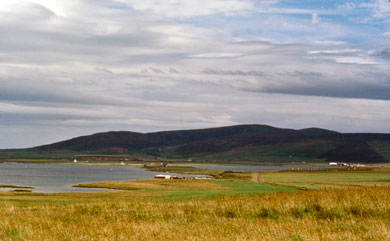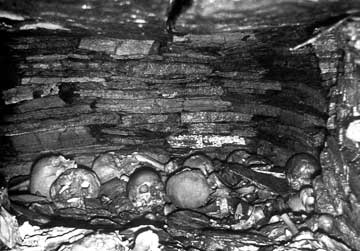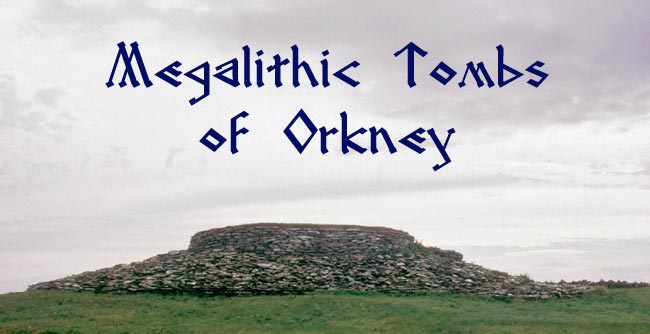
Six thousand years ago, the Orkney Islands were on the outer fringe of a megalithic tomb tradition that was found all along Europe’s Atlantic seaboard, a tradition that began about the same time that farming appeared in the region. Because of the time and effort invested in working the land to make it productive, 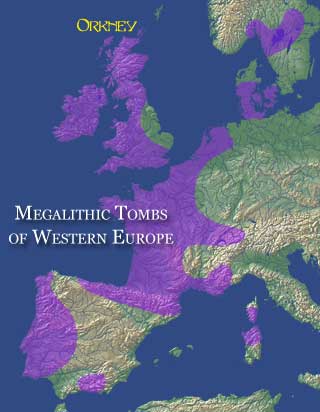 farmers tend to have strong notions of community and territoriality. The tombs were a visible expression of the group’s ownership of the land and housed the spirits of their ancestors.
farmers tend to have strong notions of community and territoriality. The tombs were a visible expression of the group’s ownership of the land and housed the spirits of their ancestors.
J.L. Davidson and Audrey Henshall catalogued 81 of them in their survey of Orkney published in 1989 and a few more have been discovered since then. As is the case elsewhere in Europe, we are only just beginning to understand their nature and function. They undoubted served as repositories for the bones of the dead— for some of the bones of certain individuals at any rate. Unfortunately, many of the tombs had been badly disturbed by later farming activity or used as a source of building material. Many of those that survived were plundered later in antiquity or during the Middle Ages. Most of those that survived intact were cleared in the eighteenth or nineteenth centuries by curious amateurs who left little or no record of their activities. From the evidence that has survived, it would seem that the deceased were represented by a loose assortment of the larger bones and the skulls, with the latter often receiving special treatment. Since none of the skeletons were found completely articulated, it is safe to assume that the bodies had been exposed somewhere else prior to interment.
Local funerary traditions varied enormously. Some tombs appear to contain the remains of the entire community while others held only a few bones. There is nothing to suggest that the deceased enjoyed any sort of afterlife but rather joined the collective ancestors, the people who had established the group’s claim to the land. The cairns served as territorial markers and as the foci of ritual activity involving relics of the past, perhaps summoning up the spirits of the ancestors to provide guidance and approval, or to intercede on the group’s behalf with the external forces that seemed to play with their lives. In that sense the cairns might be viewed as ‘shrines’ as much as tombs.
The Orcadian tombs are divided into two broad types, each associated with a different type of pottery. Orkney-Cromarty Tombs have normally contained Unstan Ware while Grooved Ware has been found in Maes Howe Tombs. Of the tombs so far discovered, all but ten are of the Orkney-Cromarty variety, a type also known as ‘stalled cairns’ because they tend to be long and have open stone compartments on either side that resemble animal stalls. The Maes Howe tombs are are much larger and more elaborate requiring ever increasing effort, numbers and organization. In most cases a distinct entrance passage leads to a central chamber with side cells.
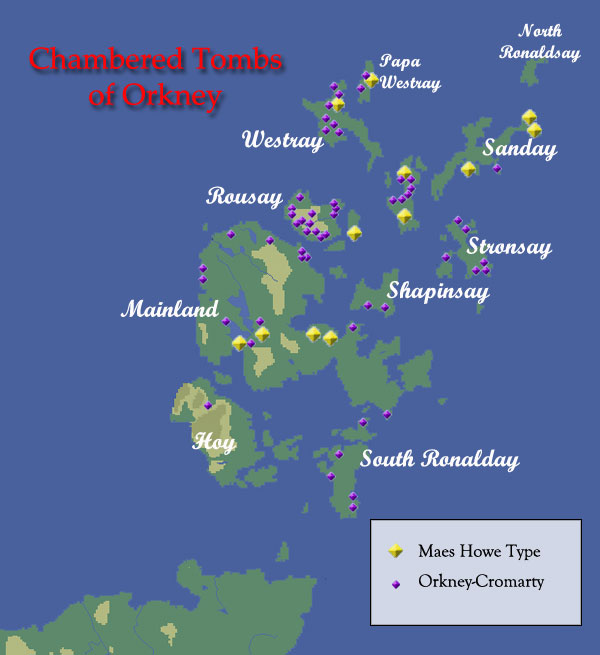
Of all the tombs, by far the most impressive is Maes Howe itself. It looks onto a pair of lochs, Harray and Stenness, separated by a spit of land. That narrow causeway is at the centre of what seems to have been a natural meeting place for the inhabitants of the islands. It is readily accessible by both land and water and surrounded by a ring of hills. While Loch Harray, to the northeast, is freshwater Loch, Stenness is open to the sea, and saline. Dualism is a common element in the human view of the cosmos and opposing principles such as male/female or summer/winter were undoubtedly of some importance to subsistence farmers.
The Tomb of the Eagles at Isbister on South Ronaldsay contained the remains of several hundred individuals, representing all age groups and both sexes in roughly the same proportions as you would expect in life. It was in use for about 700 years, from c.3300-2600 BC, and the numbers could easily account for everyone in the community who died during that period. However many of the other tombs contained only a few individuals so either there was some selection process involved to decide whether or not someone was interred or burial chambers were cleared out occasionally.
Generally, grave goods are few and undistinguished—broken pottery and stone tools for the most part. Animal bones have been found, including what must have been the remains of ritual feasts along with others, such as the white-tailed eagles found at Isbister, may have been totems. Personal ornaments such as pins and beads are rare and, given the haphazard state of the burials it would seem that the individual was of little consequence in the cosmic scheme of things. It was the collective identity of the group that mattered.
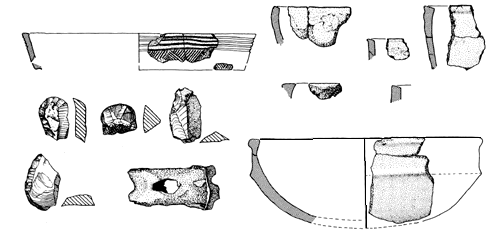
Grave good from Knowe of Rowiegar. Flint tools, pottery and a perforated ox phalange (from Davidson & Henshall, 1989)
In all societies there are certain ‘rites of passage’ that mark the life of an individual— puberty and marriage, for example— and are designed to integrate them into the group. This is of enormous importance because survival depended on every member knowing their role. Death was seen as simply 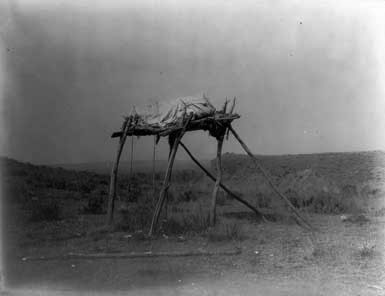 one more such rite, celebrating the union of the spirits of the deceased with those of the ancestors.
one more such rite, celebrating the union of the spirits of the deceased with those of the ancestors.
The evidence suggests that the disposal of the dead was a two-fold process. First the body was exposed until the flesh had rotted away, a process known as excarnation, which was still widely practised early in the twentieth century as shown by this photo of an Absarokee burial platform by Edward S. Curtis (right).
Then the skeletal remains (or as much of them as could be gathered) were placed inside the tomb, perhaps in a single, annual ceremony. The process would have seemed entirely logical to farmers who planted seeds in the ground and watched them sprout into new plants. Broken pottery and animal bones indicate that there was some sort of funeral service— probably involving ritual feasting and food offerings— to ensure that the newly deceased were accepted by the ancestors.
The most comprehensive study of the tombs of Orkney is The Chambered Cairns of Orkney (1989) by J.L. Davidson and A.S. Henshall.

